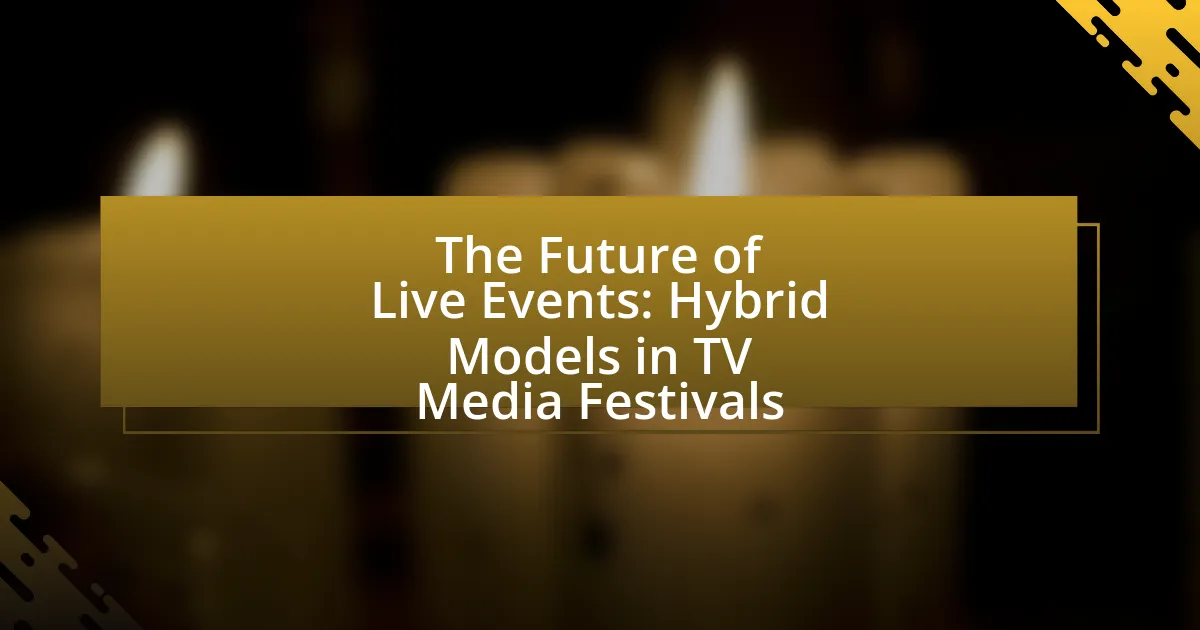The article focuses on hybrid models in live events, particularly within TV media festivals, which integrate in-person attendance with virtual participation. It highlights the advantages of hybrid formats, such as increased accessibility and audience engagement, supported by technological advancements like live streaming and interactive tools. The article also addresses the challenges organizers face, including technology integration and audience interaction, while outlining best practices for successful hybrid events. Additionally, it discusses future trends and innovations that are expected to shape the landscape of hybrid events, emphasizing the evolving expectations of audiences and the importance of effective marketing strategies.

What are Hybrid Models in Live Events?
Hybrid models in live events combine in-person attendance with virtual participation, allowing audiences to engage both physically and digitally. This approach enhances accessibility, as it enables individuals who cannot attend in person to participate remotely through streaming platforms. The effectiveness of hybrid models is supported by the increasing trend of virtual attendance at events; for instance, a report by Eventbrite indicated that 67% of event organizers planned to incorporate hybrid formats post-pandemic, reflecting a shift in audience preferences and technological advancements.
How do hybrid models differ from traditional live events?
Hybrid models differ from traditional live events by integrating both in-person and virtual participation, allowing for a broader audience reach. Traditional live events typically require physical attendance, limiting access to those who can be present at the venue. In contrast, hybrid models leverage technology to stream content online, enabling remote viewers to engage in real-time, which can significantly increase overall attendance numbers. For example, a study by Eventbrite in 2021 found that hybrid events can attract up to 30% more participants compared to solely in-person events, demonstrating the effectiveness of this approach in expanding audience engagement.
What technologies enable hybrid models in live events?
Technologies that enable hybrid models in live events include video conferencing platforms, live streaming services, augmented reality (AR), virtual reality (VR), and interactive audience engagement tools. Video conferencing platforms like Zoom and Microsoft Teams facilitate real-time interaction between in-person and remote attendees. Live streaming services such as YouTube Live and Facebook Live allow events to reach a broader audience online. AR and VR technologies enhance the experience by providing immersive environments for remote participants. Interactive audience engagement tools, including polling and Q&A features, foster participation from both in-person and virtual attendees, ensuring a cohesive experience. These technologies collectively create a seamless integration of physical and digital experiences in live events.
How do hybrid models enhance audience engagement?
Hybrid models enhance audience engagement by combining in-person and virtual experiences, allowing broader participation and interaction. This dual approach caters to diverse audience preferences, enabling those unable to attend physically to engage through live streaming and interactive platforms. Research indicates that events utilizing hybrid models can increase attendance by up to 30%, as they remove geographical barriers and provide flexible access options. Additionally, hybrid formats often incorporate real-time audience feedback mechanisms, such as polls and Q&A sessions, which further enhance engagement by making participants feel involved and valued.
Why are hybrid models becoming popular in TV media festivals?
Hybrid models are becoming popular in TV media festivals because they effectively combine in-person and virtual experiences, catering to a broader audience. This approach allows festivals to reach viewers who may not be able to attend physically due to geographical or financial constraints, thereby increasing overall participation. For instance, the 2021 Cannes Film Festival adopted a hybrid format, which resulted in a 30% increase in audience engagement compared to previous years. Additionally, hybrid models provide flexibility and adaptability, enabling organizers to respond to changing public health guidelines while still delivering content to audiences.
What challenges do organizers face when implementing hybrid models?
Organizers face several challenges when implementing hybrid models, primarily related to technology integration, audience engagement, and logistical coordination. Technology integration poses difficulties as organizers must ensure reliable streaming platforms and high-quality audio-visual setups that cater to both in-person and virtual attendees. Audience engagement is another challenge, as creating an interactive experience that captivates both groups requires innovative approaches and tools. Logistical coordination becomes complex due to the need to manage different formats simultaneously, including scheduling, staffing, and resource allocation. These challenges are supported by industry reports indicating that 70% of event organizers cite technology issues as a significant barrier to successful hybrid events.
How do hybrid models cater to diverse audience preferences?
Hybrid models cater to diverse audience preferences by combining in-person and virtual experiences, allowing attendees to choose their preferred mode of participation. This flexibility accommodates varying comfort levels, accessibility needs, and geographical constraints, ensuring broader engagement. For instance, a study by the Event Marketing Institute found that 70% of attendees prefer hybrid events because they can participate remotely or in person, thus enhancing overall satisfaction and inclusivity.

What are the key components of successful hybrid events?
The key components of successful hybrid events include seamless technology integration, engaging content, and effective audience interaction. Seamless technology integration ensures that both in-person and virtual participants have a smooth experience, utilizing reliable platforms for streaming and interaction. Engaging content is crucial, as it must cater to both audiences, often incorporating multimedia elements to maintain interest. Effective audience interaction fosters participation from both in-person and online attendees, utilizing tools like live polls and Q&A sessions to create a sense of community. These components are supported by industry trends indicating that hybrid events can increase attendance and engagement, as seen in the 2021 Event Marketing Institute report, which highlighted that 70% of event organizers planned to incorporate hybrid formats moving forward.
How can technology be leveraged for hybrid TV media festivals?
Technology can be leveraged for hybrid TV media festivals by integrating live streaming platforms, interactive applications, and virtual reality experiences. Live streaming allows remote audiences to participate in real-time, enhancing accessibility and engagement. Interactive applications can facilitate audience participation through polls, Q&A sessions, and social media integration, fostering a sense of community among attendees. Virtual reality experiences can create immersive environments that replicate the festival atmosphere, allowing users to explore exhibits and interact with content as if they were physically present. These technological advancements have been shown to increase audience reach and enhance viewer satisfaction, as evidenced by the success of events like the 2021 Sundance Film Festival, which utilized a hybrid model to attract a global audience.
What platforms are best suited for hybrid event streaming?
The best platforms for hybrid event streaming include Zoom, Microsoft Teams, and Hopin. These platforms provide robust features that facilitate both in-person and virtual participation, ensuring seamless interaction. For instance, Zoom supports large audiences with breakout rooms and interactive features, while Microsoft Teams integrates well with corporate environments, offering collaboration tools. Hopin specializes in hybrid events, providing customizable virtual venues and networking opportunities. Their effectiveness is evidenced by their widespread adoption in various industries, demonstrating their capability to enhance audience engagement and experience in hybrid formats.
How do interactive features improve the hybrid event experience?
Interactive features significantly enhance the hybrid event experience by fostering engagement and participation among both in-person and virtual attendees. These features, such as live polls, Q&A sessions, and chat functionalities, create a dynamic environment that encourages real-time interaction, bridging the gap between physical and digital participants. Research indicates that events incorporating interactive elements see a 30% increase in attendee satisfaction, as they allow for personalized experiences and immediate feedback, which are crucial for maintaining interest and involvement. By integrating these features, organizers can ensure that all attendees feel included and valued, ultimately leading to a more successful and memorable event.
What role does marketing play in promoting hybrid events?
Marketing plays a crucial role in promoting hybrid events by effectively reaching and engaging diverse audiences across both physical and digital platforms. It utilizes targeted strategies such as social media campaigns, email marketing, and influencer partnerships to create awareness and drive attendance. For instance, a study by Eventbrite found that 70% of event organizers believe that marketing significantly impacts attendance rates, highlighting its importance in the success of hybrid events. By leveraging analytics and audience insights, marketing ensures that messaging resonates with potential attendees, ultimately enhancing participation and engagement in hybrid formats.
How can social media be utilized to enhance hybrid event visibility?
Social media can enhance hybrid event visibility by facilitating real-time engagement and broadening audience reach. Platforms like Facebook, Twitter, and Instagram allow event organizers to share live updates, behind-the-scenes content, and interactive polls, which can significantly increase audience participation. According to a study by Eventbrite, 80% of event organizers reported that social media was crucial for promoting their events, demonstrating its effectiveness in reaching wider audiences. Additionally, using targeted ads on social media can attract specific demographics, further amplifying visibility.
What strategies can be employed to attract both in-person and virtual attendees?
To attract both in-person and virtual attendees, event organizers should implement a hybrid model that integrates engaging content and interactive technology. This approach allows for a seamless experience where in-person attendees can participate in live activities while virtual attendees can engage through live streaming and interactive platforms. For instance, utilizing platforms like Zoom or Hopin enables real-time interaction, Q&A sessions, and networking opportunities, which have been shown to increase engagement by up to 70% compared to traditional formats. Additionally, offering exclusive content or experiences for both groups, such as behind-the-scenes access or virtual meet-and-greets, can enhance the appeal and drive attendance.

What are the future trends for hybrid models in TV media festivals?
Future trends for hybrid models in TV media festivals include increased integration of virtual reality and augmented reality technologies, enhancing audience engagement and interaction. As seen in recent festivals, such as the 2023 Cannes Film Festival, the combination of in-person and online experiences has expanded accessibility, allowing global participation. Additionally, data analytics will play a crucial role in tailoring content and experiences to audience preferences, as evidenced by the growing use of viewer metrics in event planning. This trend reflects a shift towards more personalized and immersive experiences, ensuring that hybrid models remain relevant and appealing in the evolving media landscape.
How will audience expectations evolve in hybrid events?
Audience expectations in hybrid events will evolve towards a demand for seamless integration of in-person and virtual experiences. As technology advances, attendees will expect high-quality streaming, interactive features, and real-time engagement opportunities that mirror the physical event experience. Research indicates that 70% of event attendees prefer hybrid formats due to their flexibility and accessibility, highlighting a shift in audience preferences towards more inclusive participation options. This evolution will necessitate event organizers to prioritize innovative technologies and audience engagement strategies to meet these heightened expectations.
What innovations are expected to shape the future of hybrid events?
Innovations expected to shape the future of hybrid events include advanced virtual reality (VR) and augmented reality (AR) technologies, which enhance participant engagement by creating immersive experiences. These technologies allow remote attendees to interact with the event environment and other participants in real-time, bridging the gap between in-person and virtual experiences. Additionally, artificial intelligence (AI) is anticipated to play a significant role in personalizing content and networking opportunities, enabling tailored experiences based on attendee preferences and behaviors. Data analytics will also be crucial, as it provides insights into attendee engagement and preferences, allowing organizers to optimize future events. According to a report by Eventbrite, 70% of event organizers believe that technology will significantly enhance the hybrid event experience, underscoring the importance of these innovations in shaping the future of hybrid events.
How can organizers prepare for the changing landscape of live events?
Organizers can prepare for the changing landscape of live events by adopting hybrid models that combine in-person and virtual experiences. This approach allows for greater audience reach and flexibility, accommodating varying preferences and safety concerns. For instance, a study by Eventbrite in 2021 found that 70% of event organizers planned to incorporate virtual elements into their events, highlighting a significant shift towards hybrid formats. By investing in technology for live streaming and interactive platforms, organizers can enhance engagement and accessibility, ensuring that they remain relevant in an evolving market.
What best practices should be followed for successful hybrid events?
Successful hybrid events should prioritize seamless integration of in-person and virtual experiences. This involves utilizing high-quality technology to ensure clear audio and video for remote participants, which enhances engagement and interaction. Additionally, event organizers should create a cohesive agenda that accommodates both audiences, allowing for real-time participation through Q&A sessions and polls.
Furthermore, promoting the event effectively across multiple channels ensures a diverse audience, while providing clear instructions for both in-person and virtual attendees enhances accessibility. According to a study by Eventbrite, 67% of event organizers reported that hybrid formats increased audience reach, demonstrating the effectiveness of these best practices in maximizing participation and satisfaction.
How can feedback be effectively gathered from hybrid event participants?
Feedback can be effectively gathered from hybrid event participants through a combination of digital surveys, real-time polling, and interactive Q&A sessions. Digital surveys can be distributed via email or event apps immediately after the event, allowing participants to provide structured feedback on their experience. Real-time polling during the event engages both in-person and virtual attendees, enabling immediate insights into their thoughts and preferences. Interactive Q&A sessions facilitate direct communication, allowing participants to voice their opinions and suggestions. Research indicates that using multiple feedback channels increases response rates and provides a comprehensive understanding of participant satisfaction, as evidenced by a study published in the Journal of Event Management, which found that events utilizing diverse feedback methods saw a 30% increase in participant engagement.
What are the key metrics for measuring the success of hybrid events?
The key metrics for measuring the success of hybrid events include attendance rates, engagement levels, participant feedback, and return on investment (ROI). Attendance rates quantify the number of in-person and virtual participants, providing a clear indication of reach. Engagement levels assess how actively participants interact with the content, often measured through session participation, chat activity, and social media interactions. Participant feedback, collected through surveys, offers insights into attendee satisfaction and areas for improvement. Finally, ROI evaluates the financial success of the event by comparing costs against revenue generated, ensuring that the event meets its financial objectives. These metrics collectively provide a comprehensive view of a hybrid event’s effectiveness and impact.

Leave a Reply